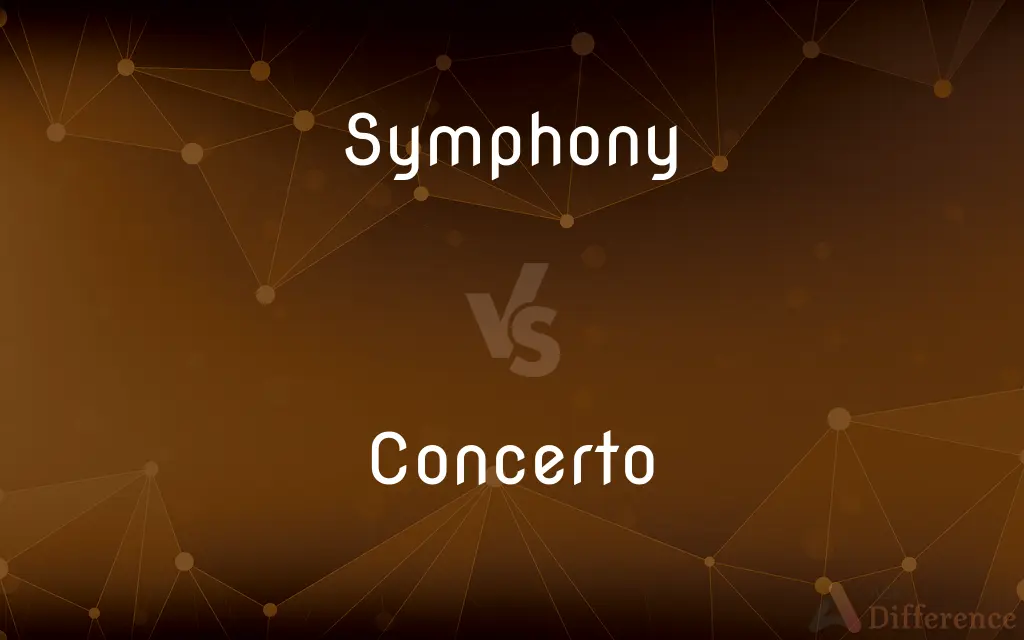Symphony vs. Concerto — What's the Difference?
By Urooj Arif & Maham Liaqat — Updated on May 2, 2024
A symphony is a large-scale musical composition typically for an orchestra, involving multiple movements; a concerto is also a multi-movement composition but focuses on a soloist accompanied by an orchestra.

Difference Between Symphony and Concerto
Table of Contents
ADVERTISEMENT
Key Differences
Symphonies are elaborate compositions that engage the entire orchestra, featuring instruments from different families including strings, brass, woodwinds, and percussion. The structure usually encompasses three to four movements that vary in tempo and character. In contrast, concertos are distinguished by their showcase of a solo performer, such as a pianist or violinist, set against the backdrop of orchestral accompaniment, often highlighting the virtuosic abilities of the soloist.
The origins of the symphony trace back to the 18th century, developing through the works of composers like Haydn and Mozart, and later expanded by Beethoven and others. Concertos, however, have a rich history that includes soloistic displays going back to the Baroque era with composers like Vivaldi and Bach, emphasizing a dialogue or competition between the soloist and the orchestra.
Symphonies are typically seen as a collective orchestral effort without emphasizing any single instrument; their movements can include sonatas, dances, and themes with variations. On the other hand, a concerto, while also multi-movement, frequently features a fast-slow-fast sequence, with the soloist performing cadenzas unaccompanied showpieces near the ends of movements.
Audiences appreciate symphonies for their complex interplay of themes and orchestral textures, presenting a unified yet diverse sound palette. Conversely, concertos offer audiences the thrill of technical mastery and personal expression of the soloist, often making the soloist the star of the performance.
From a performance perspective, playing a symphony requires a collective understanding and interpretation amongst a large group of musicians, while a concerto demands exceptional skill and charisma from the soloist, in addition to collaborative energy with the orchestra.
ADVERTISEMENT
Comparison Chart
Composition
Involves the entire orchestra.
Focuses on a soloist with orchestral accompaniment.
Movements
Usually three to four, varying in style and tempo.
Typically three, often following a fast-slow-fast format.
Historical Development
Evolved during the 18th century.
Has roots in the Baroque era.
Musical Focus
Emphasizes complex orchestral textures and themes.
Highlights the soloist's virtuosity and interaction with the orchestra.
Performance
Demands collective cohesion of the orchestra.
Centers on the soloist’s skill and the orchestra's supportive role.
Compare with Definitions
Symphony
Known for thematic development and orchestral interplay.
The composer used the symphony to explore complex thematic relationships.
Concerto
A musical composition featuring a soloist accompanied by an orchestra.
The violin concerto highlighted her extraordinary skills as a soloist.
Symphony
A complex orchestral composition in several movements.
Beethoven’s Fifth Symphony remains one of the most iconic works in classical music.
Concerto
Balances solo virtuosity with orchestral collaboration.
The concerto showcased a perfect balance between the cellist and the orchestral accompaniment.
Symphony
Represents a pinnacle of orchestral achievement.
Writing a symphony is often seen as a major accomplishment for a composer.
Concerto
Popular in both Baroque and Classical periods.
Mozart’s concertos for horn are still celebrated for their lyrical beauty and technical demands.
Symphony
Emphasizes a variety of musical expressions and dynamics.
The symphony moved from a dramatic first movement to a tranquil second.
Concerto
Structured around three movements with potential cadenzas.
The pianist performed an elaborate cadenza in the first movement of the concerto.
Symphony
Performed by a full orchestra, including a wide range of instruments.
The orchestra rehearsed the challenging symphony for weeks.
Concerto
Often showcases a particular instrument’s capabilities.
The trumpet concerto was a dazzling display of the instrument’s range and expressiveness.
Symphony
A symphony is an extended musical composition in Western classical music, written by composers, most often for orchestra. Although the term has had many meanings from its origins in the ancient Greek era, by the late 18th century the word had taken on the meaning common today: a work usually consisting of multiple distinct sections or movements, often four, with the first movement in sonata form.
Concerto
A concerto (; plural concertos, or concerti from the Italian plural) is, from the late Baroque era, mostly understood as an instrumental composition, written for one or more soloists accompanied by an orchestra or other ensemble. The typical three-movement structure, a slow movement (e.g., lento or adagio) preceded and followed by fast movements (e.g.
Symphony
An extended piece in three or more movements for symphony orchestra.
Concerto
A composition for an orchestra and one or more solo instruments, typically in three movements.
Symphony
An instrumental passage in a vocal or choral composition.
Concerto
(music) A piece of music for one or more solo instruments and orchestra.
Symphony
An instrumental overture or interlude, as in early opera.
Concerto
A composition (usually in symphonic form with three movements) in which one instrument (or two or three) stands out in bold relief against the orchestra, or accompaniment, so as to display its qualities or the performer's skill.
Symphony
A symphony orchestra.
Concerto
A composition for orchestra and a soloist
Symphony
An orchestral concert.
Symphony
Harmony, especially of sound or color.
Symphony
Something characterized by a harmonious combination of elements.
Symphony
An extended piece of music of sophisticated structure, usually for orchestra.
Symphony
(music) An instrumental introduction or termination to a vocal composition.
Symphony
Harmony in music or colour, or a harmonious combination of elements.
Symphony
A symphony orchestra.
Symphony
A consonance or harmony of sounds, agreeable to the ear, whether the sounds are vocal or instrumental, or both.
The trumpets sound,And warlike symphony in heard around.
Symphony
A stringed instrument formerly in use, somewhat resembling the virginal.
With harp and pipe and symphony.
Symphony
An elaborate instrumental composition for a full orchestra, consisting usually, like the sonata, of three or four contrasted yet inwardly related movements, as the allegro, the adagio, the minuet and trio, or scherzo, and the finale in quick time. The term has recently been applied to large orchestral works in freer form, with arguments or programmes to explain their meaning, such as the "symphonic poems" of Liszt. The term was formerly applied to any composition for an orchestra, as overtures, etc., and still earlier, to certain compositions partly vocal, partly instrumental.
Symphony
A long and complex sonata for symphony orchestra
Symphony
A large orchestra; can perform symphonies;
We heard the Vienna symphony
Common Curiosities
What distinguishes a symphony from a concerto?
A symphony involves the entire orchestra with multiple complex parts, whereas a concerto focuses on a soloist accompanied by an orchestra.
How many movements does a typical symphony have?
A typical symphony has three to four movements.
Can any instrument be featured in a concerto?
Virtually any instrument can be featured as a soloist in a concerto, from pianos and violins to less common instruments like the marimba or saxophone.
What is a cadenza in a concerto?
A cadenza is an elaborate, solo passage where the soloist plays unaccompanied, typically towards the end of a movement.
Are there famous composers known for both symphonies and concertos?
Yes, composers like Beethoven, Brahms, and Mozart are celebrated for their significant contributions to both symphonic and concerto repertoires.
How has the form of concertos evolved over time?
Concertos have evolved from the simple Baroque forms focusing on instrumental brilliance to more complex structures in the Romantic era that explore deep emotional expressions.
How does the role of the conductor differ between a symphony and a concerto?
In a symphony, the conductor focuses on the unity and balance of the entire orchestra, while in a concerto, the conductor also supports the soloist’s interpretation and integration with the orchestra.
What are some challenges orchestras face when performing symphonies?
Challenges include maintaining the balance between sections, managing the dynamics and tempo across lengthy movements, and interpreting the conductor’s vision into a cohesive performance.
What are some key listening points for audiences new to symphonies and concertos?
For symphonies, listen for thematic development across movements and the interplay of different orchestra sections. In concertos, focus on the interaction between the soloist and the orchestra and the technical prowess of the soloist.
Why might a composer choose to write a concerto?
Composers write concertos to showcase the virtuosity of a solo performer, often for specific musicians, and to explore the expressive capabilities of particular instruments.
Share Your Discovery

Previous Comparison
Clubhouse vs. Club
Next Comparison
Rastafarian vs. ChristianAuthor Spotlight
Written by
Urooj ArifUrooj is a skilled content writer at Ask Difference, known for her exceptional ability to simplify complex topics into engaging and informative content. With a passion for research and a flair for clear, concise writing, she consistently delivers articles that resonate with our diverse audience.
Co-written by
Maham Liaqat















































